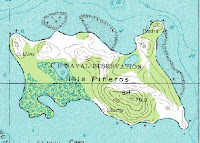
LOG: Thursday, May 26, 2010. Sailboat: Bébé (41’ Beneteau). Winds: S, SW 9-14, 10-15 Knots. Seas: 2-4 ft. Weather: 87ºF, overcast, showers & isolated T-storms. Barometer: 29.91 (steady). Sky: complete thick cloud coverage, cumulus nimbus. Crew: Capt. Michael, myself and two new sailing students, Kevin and Julie (from the Island of Vieques). Special features: Full moon night, 19:54 moonrise; rendered invisible through thick clouds. Time out: 13:30, 5/26/10. Time back: 16:30, 5/27/10.
It was a dark and stormy night, when the captain said to the first mate, “Tell us a story.” and the mate began, … It was a dark and stormy night, when the captain said to the first mate, ‘Tell us a story.’ and the mate began, …
This is a circular sailing story that connects us to a primal story we cannot even fathom to understand. Such is the power of the sea story on a stormy night. The full moon’s tugging power makes it even stronger because the clouds and rain render it invisible. The tug affects the sea as it affects the fluids in our bodies; our emotions and senses.

We left port under a low-low tide (due to the full moon) and arrived at Isla Piñeros, four hours later, under a high-high tide. In the Caribbean, tides ebb and flood about a foot (down a foot, up a foot, …). Under a full moon, there is nearly a three-foot difference. As we left port at Sunbay Marina, we saw coral reefs’ sharp top edges in rows as shark teeth, where normally they are never seen. We know they are there by studying charts, GPS images and snorkeling visuals. They were visible in strength today because of the full moon.
The wind was blowing from the south and according to NOAA, it would change to SW during the night. South winds do not happen often in the constant easterly Tradewinds region. The normal easterly winds make for uncomfortable sailboat movements during visits and overnight stays at Isla Piñeros. Its coastline is surrounded by irregular shallow coral reefs, another reason why it is not often visited. Prevailing S and SW winds made it just right to overnight by the island.
We approached it as Pinzón could have approached it on a visit to Puerto Rico (Martín Alonso Pinzón was captain of the Pinta. His younger brother, Vicente Yañez Pinzón was captain of the Niña in Columbus’s expedition in 1492.). Kevin was lookout at the bow, kneeling over looking out for uncharted reefs and a sandy spot to anchor. Julie checked the charts and I was following with the GPS, noting the approach. For those interested, you aim at the center of the northeast bay where there is a rocky promontory, at a 205º heading to avoid reefs (exit straight out at a 025º heading).
After we anchored for the night, the winds and waves freshened. Our anchor faced us into the wind, but the current hit the sailboat abeam (on the side), creating a not so comfortable rocking motion. I learned to do a bridle on the anchor. You tie a rolling hitch with the end of a long line to the anchor line at the bow. The standing part of that rolling hitch line is cleated midship to a horn cleat. You give more scope to your main anchor until the bridle moves the bow to the current. The calming effect is immediate. After a BBQ dinner hosted by Kevin and Julie, we slept in the comfort of a gentle sea sway.

On Friday morning, the Captain snorkeled the coast to check the reef area. Kevin and Julie checked the anchors. I stayed onboard and took care of the galley mess from the night before, plus jotted some notes for this blog. Even though the visibility was not great due to the weather, two manta rays and blue tropical fish schools were sighted.
We returned with freshening winds, so we reefed the main and changed the genoa to a jib; a smaller sail area. There was some rain on the way back and we wore our rain jackets. It was good to practice sailing under the rain with freshening seas under the expertise of Capt. Michael. The skies never cleared and we never saw the moon, but we felt her presence and inspiring tug.
--Full Moon Unseen--
Feeling moon’s tug on me
Raining wind’s harmony
Sweet music on shrouds’ strings
Shrouds resounding white wings
Cloudy night sky’s high C
Sailing Caribbean Sea


 On Friday morning, the Captain snorkeled the coast to check the reef area. Kevin and Julie checked the anchors. I stayed onboard and took care of the galley mess from the night before, plus jotted some notes for this blog. Even though the visibility was not great due to the weather, two manta rays and blue tropical fish schools were sighted.
On Friday morning, the Captain snorkeled the coast to check the reef area. Kevin and Julie checked the anchors. I stayed onboard and took care of the galley mess from the night before, plus jotted some notes for this blog. Even though the visibility was not great due to the weather, two manta rays and blue tropical fish schools were sighted.

